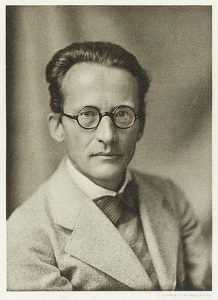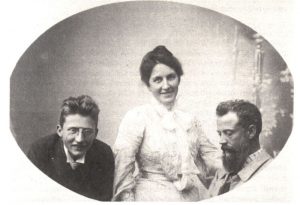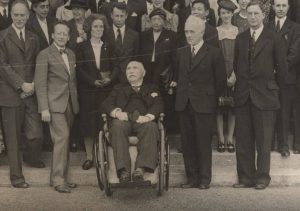
In several previous posts we have described how one part of Physics evolved, the one related to the microscopic world of atoms, their spectra, etc. Perhaps the two most surprising results we have seen were those of Einstein asserting that light behaved not only as a wave but also as a particle, recovering the Newtonian corpuscular theory (see HERE and HERE), and of De Broglie asserting that particles (especially electrons) also behaved as waves, establishing what is known as wave-particle duality (see HERE). Although this last “discovery” by De Broglie gave some physical justification to Bohr’s “strange” theory of atoms (Bohr’s atomic model is discussed HERE), too many questions remained open. In fact, Bohr himself was aware of this, so everyone was waiting for a theory to emerge that would be able to shed some light on the problem. The curious thing about this story is that two theories appeared almost at the same time (not one, my dear reader, but two!): Heisenberg’s Matrix Mechanics (later developed by Heisenberg, Born and Jordan) and Schrödinger’s Wave Mechanics. In this article we will briefly discuss the genesis of the second of the two theories, which in the long run has been the prevailing one.
If we wanted to be thorough with history, we would have to devote a lot of space to explain how Schrödinger, practically an unknown, was able to find (or discover, as the reader prefers) the equation that governs the microscopic (non-relativistic) world. We will restrict ourselves to a few outlines to show that, although mathematics had been important for the understanding of the quantum world until now, with Schrödinger it became essential. A detailed and entertaining history of Schrödinger’s life can be found in Jesus Navarro’s magnificent book “Schrödinger: una ecuación y un gato” (Schrödinger: an equation and a cat), published by Nivola in 2009.

Before describing the story of how Schrödinger “discovered” his equation, it is worth mentioning some of his peculiarities. Erwin Schrödinger was born into a wealthy Viennese family. His formal education began at the Gymnasium, until then he was educated “at home” like most of the children of wealthy Viennese families. It was his father who instilled in him an interest in science and culture in general, so much so that Erwin was not only interested in science, but also in Latin and Greek, was an enthusiast of Greek philosophy and loved writing poetry. In 1906 he entered the University of Vienna to study physics and mathematics (after ruling out poetry, which he told an English journalist years later would not provide him with enough to eat, but this did not prevent him from devoting part of his time to writing poetry, especially to seduce women, as he was an inveterate womaniser). In 1910 he finished his studies and in 1914 he obtained the licence that would allow him to take up a teaching post. Between 1911 and 1914 he wrote several articles, mostly experimental, but in 1914 he decided that experiments were not his thing. Unfortunately, in the summer of 1914, World War I broke out and Schrödinger was called up as an officer. A curious fact is that throughout the war period he was able to write several scientific articles covering many of the current issues of the day. After the war he had no choice but to stay (much to his regret, as he himself would say) at the Institute of Physics in Vienna and devote himself to physics (fortunately, since his intention was to focus on philosophy). After several wanderings, he ended up at the University of Zurich, which he joined in 1922. It was there that he developed the theory that would earn him the respect of the scientific community, the Nobel Prize in Physics, and eventually his place in history.
What did Schrödinger achieve? Well, he found an equation that explained, among other things, the spectrum of the hydrogen atom, which we have already discussed HERE. A very well-documented story is told by Sánchez Ron in his magnificent monograph “Historia de la física cuántica” (History of quantum physics). Interestingly, there is a very specific account of how Schrödinger –who in his own words had never followed a main line of research and his work was inspired to contradict or correct– came to discover one of the most important mathematical equations, the one that today bears his name, and which describes the subatomic world with great precision.
The story goes as follows. At the end of 1925, a joint seminar took place between physicists at the Swiss Federal Institute of Technology in Zurich (ETH), led by Peter Debye (Nobel Prize in Chemistry in 1936), and physicists at the University of Zurich, including Schrödinger, to discuss recent results in the field. It was at one of these meetings that it all started. But let’s leave it to Felix Bloch (Nobel Prize in physics in 1952), a student at the ETH at the time, to tell us about it:
Once, at the end of a workshop, I heard Debye say something like: “Schrödinger, since you’re not working on very important problems right now, why don’t you tell us sometime about that thesis of De Broglie, which seems to have attracted some attention?” Then, in one of the following discussions, Schrödinger gave a wonderfully clear account of how De Broglie associated a wave with a particle and how he was able to obtain the quantization rules of Niels Bohr and Sommerfeld by requiring that an integer number of waves be fitted along a stationary orbit.
When he finished, Debye casually remarked that he thought this way of talking was rather childish. As a student of Sommerfeld, he had learned that, to deal properly with waves, it was necessary to have a wave equation. It sounded rather trivial and did not seem to make much of an impression, but evidently Schrödinger thought further about the idea afterwards.
Just a few weeks later he gave another talk at the workshop which began: “My colleague Debye suggested that one should have a wave equation; well, I have found one!” And then he told us essentially what he was about to publish under the title “Quantization as an eigenvalue problem” as the first paper in a series in Annalen der Physik. I was still too new to really appreciate the significance of this talk, but from the general reaction of the audience I realised that something quite important had happened, and I don’t need to say what Schrödinger’s name has meant from then on.

It seems that at Christmas of that year Schrödinger went on holiday to Arosa (Switzerland), where he often went because of his tuberculosis, and there he came up with his famous equation, as he tells in a letter to the physicist W. Wien, dated 27 December 1925, with whom he maintained an intense epistolary communication. In that letter he wrote that he had found a model whose “self-frequencies” matched those of the hydrogen atom, and that this model was constructed in a reasonably natural way and not by means of ad hoc assumptions, and that he would soon send him the results, but first he had to learn the mathematics necessary to deal with the differential equation he had found.
Wien was at that time the editor of the prestigious journal Annalen der Physik, and indeed, on 27 January 1926, an article signed by Schrödinger entitled “Quantisierung als Eigenwertproblem” (“Quantization as an Eigenvalue Problem”) was received in the editorial office of the Annalen der Physik, the first of a series of four in which Schrödinger laid the foundations of what we know today as Quantum Wave Mechanics. In it, Schrödinger wrote the (stationary) equation modelling the (non-relativistic) hydrogen atom that would later bear his name:
$$\Delta \psi + \frac{8\pi^2 m}{h^2}\left( E+\frac{e^2}{r}\right)\psi=0,$$
where \(\Delta\) is the Laplacian operator, which in Cartesian coordinates is written as
$$\Delta\psi=\frac{\partial^2 \psi}{\partial x^2}+\frac{\partial^2 \psi}{\partial y^2}+\frac{\partial^2 \psi}{\partial z^2},$$
and obtained for the \(E\) energy levels of hydrogen the values
$$E_l=-\frac{2\pi me^4}{h^2 l^2},$$
where \(h\) is Planck’s constant and \(l\) is the principal quantum number. In other words, he recovered the mysterious Bohr formula that we talked about in a previous post. Everything seemed to fit except for one thing: what was the physical meaning of the \(\psi(x,y,z)\) function?
Aware of this problem, Schrödinger writes that, for the moment, he does not intend to explain it, and that he prefers to leave it as it is, because it shows what is essential for him: that “the postulate of the “integers” no longer enters mysteriously into the quantum rules but that we have taken a step further in identifying its origin, finding that “integerness” has its origin in finiteness and uniqueness of a certain space of functions”; and he goes on to state “I do not want to discuss further the possible representations of the process of vibrations until other more complicated cases have been successfully calculated from this new point of view”. This is what he did in successive articles, where he already wrote the equation for other physical systems in the form we know today. In particular, in the fourth paper of the series he introduced the time-dependent equation (non-stationary equation), where now \(\psi\) is a function that also depends on t:
$$- \frac{h^2}{8m\pi^2} \Delta \psi +V(x,y,z) \psi= \frac{i h}{2\pi}\frac{\partial\psi}{\partial t}, \quad i=\sqrt{-1},$$

from which it followed that, in general, the \(\psi\) function was a complex function. This was also something that Schrödinger was concerned about, and he mentions it at the end of the paper, saying that he hopes that the state of the system can eventually be written in terms of a real function and its time derivative (something that unfortunately was not going to be possible in general, as Max Born pointed out shortly afterwards).
The success of Schrödinger’s equation was enormous, receiving almost instant support from Einstein, who said that “[Schrödinger] has made a decisive breakthrough with his formulation of the quantum condition…”, or from Planck, who read his papers “like a curious child listens with suspense to the solution of a puzzle that has troubled him for a long time”. In fact, Planck went further and convinced the Berlin university authorities to offer Schrödinger the professorship he was to vacate upon his upcoming retirement, where he joined as a professor on 1 October 1927 until he resigned during the 1933 holiday, the same year he received the Nobel Prize, and did not return to Berlin because of his disgust at the rise of Nazism.

From then on, his life was a complete whirlwind. In November 1933 he took up a teaching post at Oxford, where he lived until he accepted a post in Graz, his native Austria in 1936, which he left when Hitler annexed Austria to Germany in 1938. His flight from Austria is like a horror film, and Schrödinger was not Jewish – what would have happened if he had been? Finally, at the expense of the Prime Minister of Ireland, Éamon de Valera, in 1940 he was appointed director of the Theoretical Physics department at the Institute for Advanced Study in Dublin, Ireland, where he remained until 1956, when he returned with his wife to his native Vienna after 36 years of exile. He died in Vienna at the age of 73 from tuberculosis. Interestingly, Schrödinger and Einstein share the “merit” of being the only scientists whose names were erased from all German scientific institutions during the Nazi regime.
But to return to Schrödinger’s contribution, was it thanks to quantum wave mechanics that the infamous second little cloud that Lord Kelvin mentioned in his well-known lecture of 1900 had finally dissolved? To be honest, there was still a long way to go, and understanding the meaning of Schrödinger’s \(\psi\) wave function triggered one of the greatest controversies in science as a result of the interpretation by Max Born, another of the great physicists we mentioned earlier, but that is another story worth telling, and we will do so in a later post.

Leave a Reply